
Kate Barrington / Cats.com
Why spend your time scooping the litter box if you don’t have to? Automatic, self-cleaning litter boxes do the work for you and some of them come with some pretty impressive features.
One of our favorite automatic litter boxes, the Litter-Robot III Connect, is WiFi enabled for smartphone connection through the Whisker app. The LitterMaid is much simpler in design but much more affordable as well.
In this guide, we’ll explore the details of both litter boxes and what makes them unique. You’ll learn everything you need to know to make an informed decision between the two options.
Head to Head Comparison
| Litter-Robot | LitterMaid | |
| Number of Reviews
Reviews averaged and content pulled from company websites as well as third-party e-commerce sites. |
19,000+ | 10,000+ |
| Made in the USA
You should know where your pet appliances are made. |
Designed & assembled in the USA (factory in Juneau, AK) | Spectrum Brands is headquartered in Earth City, MO with manufacturing facilities in the US, Mexico, Taiwan, China, and the Philippines |
| Years in Business
Is the product manufactured by a longstanding, successful company? |
22 | 1997 |
| Warranty
Your investment should be backed by a full-service warranty. |
18-month full-coverage warranty; extended 3-year warranty available | 12-month warranty |
| Money-Back Guarantee
Buy with confidence knowing you can get a refund if unsatisfied. |
90-day in-home trial + money-back guarantee (must pay return shipping) | 90-day money-back guarantee |
| Payment Plan
Can you “buy now, pay later” with stress-free financing plans? |
3-, 6- & 12-month plans available with Affirm | None |
| WiFi-Enabled
Smart pet appliances can be remotely monitored and controlled through the app. |
The first self-cleaning litter box with WiFi capabilities; get notifications and monitor litter box habits with the Whisker app | None |
| Sifting Technology
What makes this pet appliance self-cleaning? |
Original patented gravity-driven litter-sifting technology | Cleaning rake with automatic sensors |
| Product Design
The appliance should be designed with both pets and pet parents in mind. |
Orbital design with large entry | Open litter tray design |
Background on the Litter-Robot III Connect
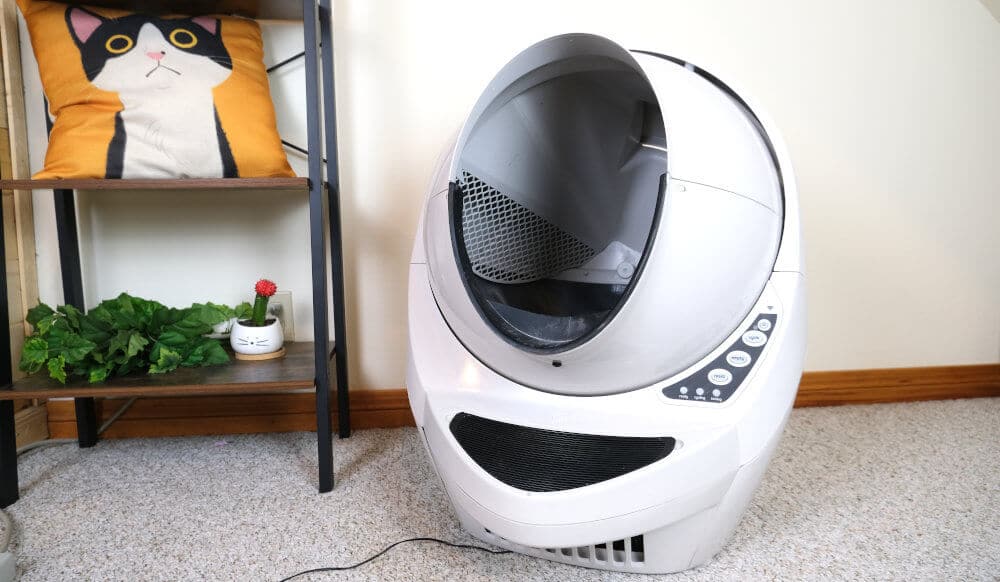
Kate Barrington / Cats.com
Ratings
- Ease of Cleaning – 5/5
- Odor Control – 5/5
- Appearance – 4.5/5
- Construction – 4.5/5
- Price – 3.5/5
Overall Score: 4.5/5
The Litter-Robot III Connect is Whisker’s most recent edition. It’s a large, fully automatic, WiFi enabled litter box you can monitor and control through a smartphone app. The Litter-Robot III is also available in a standard version that offers all the same features minus the WiFi connectivity.
Mallory Crusta, our Head of Content, tested the Litter-Robot III in mid-2020 and I tested it myself earlier that year. Check out Mallory’s in-depth video review of the Litter-Robot III on the Cats.com YouTube channel.
The Litter-Robot III is a sizable device with a total footprint of 30-by-25-by-27 inches. It features a globe-shaped design with an ovular entry in the center. To access the litter bed, your cat uses a small step that stands about 7 inches off the ground.
This litter box utilizes gravity to separate clumps from clean cat litter. Weight sensors inside the unit detect your cat’s presence then initiate a cleaning cycle between 3 and 15 minutes after your cat leaves. You can adjust the length of the waiting period on the unit directly or through the Whisker app.
During a cleaning cycle, the globe itself rotates, causing the litter to slide into two separate compartments. Clean litter sifts through a grate into a storage compartment while dirty litter tumbles into a waste receptacle housed in the base of the unit.
As an enclosed litter box, the Litter-Robot offers strong odor control. The Whisker app enables you to keep track of your cat’s litter box usage and you can monitor the waste drawer level as well.
Background on the Littermaid
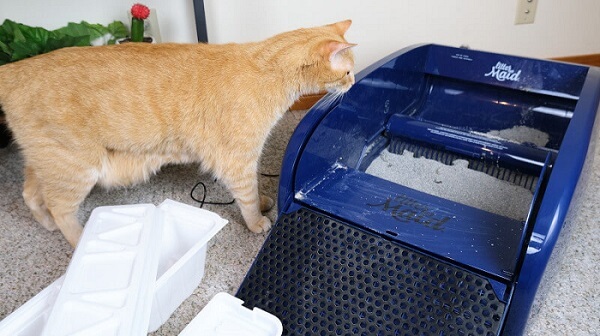
Kate Barrington / Cats.com
Ratings
- Ease of Cleaning – 3.5/5
- Odor Control – 4/5
- Appearance – 4/5
- Construction – 4/5
- Price – 4.5/5
Overall Score: 4/5
LitterMaid is owned by Spectrum Brands. As a brand, LitterMaid was founded in 1997 under the name Windmere, but has operated under the LitterMaid name since 2001. The LitterMaid is a fully automatic, self-cleaning litter box that has recently been released in its third edition.
Mallory Crusta, our Head of Content, tested the LitterMaid in 2021. Check out her in-depth video review of the LitterMaid on the Cats.com YouTube channel.
The LitterMaid is an open litter box modeled after the shape of a traditional litter pan. It measures 17 inches wide by 24 inches long and 10 inches high. There’s a second version of the litter box marketed for multi-cat households that offers an additional two inches of length.
This litter box is very similar in form and function to the PetSafe ScoopFree self-cleaning litter box. It is equipped with a plastic rake that sweeps across the litter bed, moving dirty litter into a waste receptacle at the front of the box. The unit operates automatically, initiating a cleaning cycle 10 minutes after the sensor is blocked for a period of 10 seconds or more.
Like most automatic litter boxes, the LitterMaid deposits dirty litter into a waste receptacle. Rather than having a fixed compartment lined with a bag, however, this unit requires disposable plastic receptacles that are sold separately. You can also purchase carbon filters that fit into the receptacle to help combat litter box odor.
Now, Let’s Take a Look at How the Litter-Robot Iii Compares With the Littermaid
Both the LitterMaid and the Litter-Robot are fully automatic, self-cleaning litter boxes. They serve the primary purpose of removing the hassle of scooping, though they utilize two very different forms of technology to do it. They also have very disparate features and technological capabilities.
To compare and contrast these two litter boxes, we’ll take a closer look at the following categories:
Let’s dive into the details in each of these categories.
1. Size And Setup
Both the Litter-Robot and the LitterMaid take up a significant amount of space. This shouldn’t be surprising given the technology they use that sets them apart from traditional litter boxes.
The Litter-Robot measures 30-by-25-by-27 inches, making it almost as tall as it is wide. The LitterMaid measures 24-by-17-by-10 inches. It’s about six inches shorter in length than the Litter-Robot and nearly 18 inches shorter in height. This size difference affects the size of the usable litter bed inside each unit.
The actual litter bed in the Litter-Robot only ends up measuring about 14-by-14 inches. The LitterMaid is about an inch narrower at 14-by-13 inches.
The Litter-Robot is much larger than the LitterMaid, so it only makes sense that the packaging is bigger. The good news is this litter box comes almost fully assembled – you need only place the litter mat on the step and add litter before you can start using it.
The LitterMaid comes fully assembled as well though, again, you’ll need to install the ramp that also functions as a litter catcher. It comes with four waste receptacles and four carbon filters as well as a scoop and rake cleaner.
Neither unit is particularly difficult to set up – the process only took about five minutes for each. The Litter-Robot may be larger, but the functional space inside the two is similar.
Size and Setup Winner: A draw
2. Operation and Performance
While both the Litter-Robot III and the LitterMaid are automatic, self-cleaning litter boxes, they utilize very different technology. One of the two clearly functions more efficiently than the other.
The LitterMaid utilizes a plastic rake to separate clean from dirty litter. As the rake sweeps across the litter bed, it collects clumps and deposits them in a covered waste receptacle before moving back into place at the back of the unit.
In contrast, the Litter-Robot is a gravity-based system that physically separates clean and dirty litter. Clean litter filters through a grate while dirty litter tumbles into the waste receptacle.
Both of these units have an automatic timer that initiates a cleaning cycle after a predetermined amount of time. The Litter-Robot uses weight sensors to detect your cat’s presence while the LitterMaid uses a visual sensor. The LitterMaid automatically initiates after 10 minutes but you can adjust the waiting period on the Litter-Robot between 3 and 15 minutes.
Now that you understand the basics of each model’s performance, let’s take a look at how well they actually work.
Mallory and I both found the Litter-Robot to be very simple to use and highly effective. The unit worked smoothly without jamming and it did a pretty good job separating clumps from clean litter. The gravity-based system helps remove litter that sticks to the bottom or sides of the globe.
The LitterMaid is somewhat disappointing in terms of function. Mallory found that the rake moved fairly smoothly, but it was a bit loud and didn’t clean the litter bed evenly. Smaller particles were able to slip through the tines of the rake and certain parts of the litter bed accumulated waste. In the event of loose stools, the rake also became quite dirty.
To help deal with this issue, the LitterMaid comes with a specially designed scoop that enables you to collect residual clumps and scrape the tines of the rake clean.
It’s worth noting that performance for both of these models may depend to some degree on the type of litter you choose. Both require a clumping litter, though you have some freedom to choose what type. A hard- and fast-clumping litter supports optimal function.
Operation and Performance Winner: Litter-Robot
3. Odor Control and Tracking
The key to controlling litter box odor is to scoop the litter box frequently, and both these models accomplish that goal well. There’s a big difference, however, in odor between the time your cat uses the litter box and when the cleaning cycle initiates.
The Litter-Robot III has the benefit of an enclosed design which helps prevent odor from escaping the box. Once dirty litter is deposited in the covered waste compartment, the odor is barely noticeable.
Because the LitterMaid is an open litter box, you may notice more odor before the cleaning cycle initiates. Additionally, because this model isn’t particularly effective in removing all the clumps, the litter box may accumulate odor over time.
While the Litter-Robot beats out the LitterMaid in odor control, neither litter box was particularly effective in reducing tracking and litter scatter.
The Litter-Robot comes with that rubberized litter mat that sits on the step, but it’s fairly small and shallow. The entry of the litter box is fairly narrow, but it’s quite elongated which enables cats who like to dig to kick litter out of the box.
The LitterMaid comes with a ramp and a mat designed to collect litter. The matt works to some degree, but the open design of the litter box means litter can escape easily out the sides.
In terms of cleaning the litter boxes, the Litter-Robot is simpler. Not only can you line the waste drawer with a standard plastic bag, but the inside of the globe can be rinsed or wiped clean. The LitterMaid’s waste receptacles are easy to dispose of in theory, though Mallory found the process a little messy.
If you need to perform a thorough cleaning of the LitterMaid, you’ll have to take the unit apart and detaching the rake can be tricky if it falls out of alignment.
Odor Control and Tracking Winner: Litter-Robot
4. Maintenance
While automatic litter boxes do the work of scooping for you, there are some maintenance factors to consider.
The Litter-Robot works efficiently, and the gravity-based system helps keep dirty litter from accumulating on the bottom of the box. Thoroughly cleaning the box can be a little tricky because some disassembly is involved, but you can reduce the need for a deep clean by emptying and wiping down the unit at least once a week. The Litter-Robot even has an empty feature for this purpose.
The LitterMaid leaves something to be desired in terms of maintenance. It tends to leave dirty litter behind, and urine and solid waste can become stuck along the sides of the box or on the rake. If you do need to thoroughly clean the unit, it can be a little hard to take apart.
Emptying the waste compartment for either unit is fairly simple. With the Litter-Robot, you just open the waste drawer and dispose of the bag. The LitterMaid uses disposable waste receptacles you simply toss into the trash.
Maintenance Winner: Litter-Robot
5. Overall Impression
If you’re looking for an automatic, self-cleaning litter box, you can be assured that both the Litter-Robot III and the LitterMaid fit the bill. That being said, there’s a clear distinction between the two in terms of performance.
Both models give you the freedom to choose your litter, though hard-clumping clay seems to work best. This makes maintenance costs fairly similar, though the upfront investment is significantly higher for the Litter-Robot than the LitterMaid.
Another detail we’ve only touched on briefly is the Litter-Robot’s health monitoring feature. Each time your cat uses the Litter-Robot, the event is recorded on the Whisker app. Information about litter box usage can be helpful in indicating the potential for certain health problems.
The LitterMaid doesn’t offer any health monitoring benefits.
Overall, it’s hard to recommend the LitterMaid in good faith, especially when compared to the Litter-Robot. It simply doesn’t work as well, and it is extremely limited in terms of features. Cat owners seem to agree, based on hundreds of negative reviews.
How Do They Compare in Cost?
An automatic litter box is always going to be more expensive than a traditional litter pan which you can get for under $10. Self-cleaning litter boxes generally cost several hundred dollars, so the LitterMaid is definitely one of the cheapest options in this category.
The LitterMaid costs between $100 and $150, depending where you shop. That’s as much as $400 cheaper than the Litter-Robot III which is priced at $549.
Maintenance costs are similar since either works well with clumping cat litter. The main difference is the price of the disposable waste receptacles for the LitterMaid. You can purchase waste drawer liners from Litter-Robot, but a plastic grocery bag works fine as well.
Before making your decision based on the price of the unit, think about additional factors like warranty coverage and return policies.
The Litter-Robot is backed by a generous 18-month warranty, and you can extend it to three years for an additional $100 when you purchase the unit. It also comes with a 90-day money-back guarantee. The LitterMaid only comes with a 12-month warranty and the return period may vary depending on where you buy the unit.
Which Option Is Right For You?
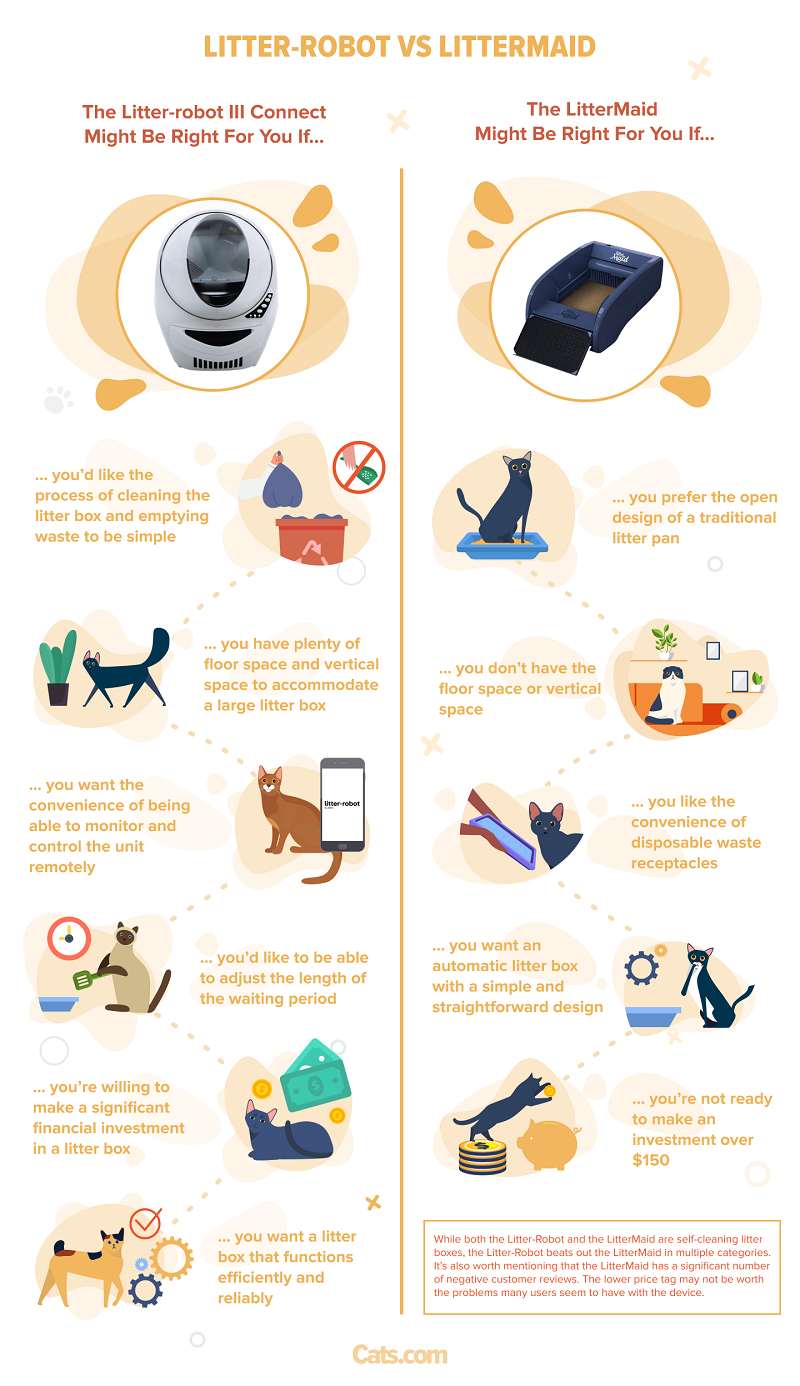
Having thoroughly tested both the LitterMaid and the Litter-Robot III Connect, we happily recommend Litter-Robot III Connect as the clear winner in 3 out of our 4 testing criteria.
That being said, there are certain cases in which one option might be more appropriate than the other.
The Litter-Robot III Connect Might Be Right For You If…
- You have plenty of floor space and vertical space to accommodate a large litter box.
- You’re willing to make a significant financial investment in a litter box.
- You want a litter box that functions efficiently and reliably.
- You’d like to be able to adjust the length of the waiting period.
- You want the convenience of being able to monitor and control the unit remotely.
- You’d like the process of cleaning the litter box and emptying waste to be simple.
The LitterMaid Might Be Right For You If…
- You’re not ready to make an investment over $150.
- You or your cat prefer the open design of a traditional litter pan.
- You want an automatic litter box with a simple and straightforward design.
- You don’t have the floor space or vertical space to accommodate the Litter-Robot.
- You like the convenience of disposable waste receptacles.
While both the Litter-Robot and the LitterMaid are self-cleaning litter boxes, the Litter-Robot beats out the LitterMaid in multiple categories. It’s also worth mentioning that the LitterMaid has a significant number of negative customer reviews. The lower price tag may not be worth the problems many users seem to have with the device.
Still not sure which option is right for you? You’ll find more in-depth information about these two litter boxes in our written and video reviews.
If you’re not ready to invest in a self-cleaning litter box, a sifting litter box might be more practical. These boxes also save you the work of scooping but they’re more limited in their self-cleaning functions.
Check out our top picks for the best sifting litter boxes here.

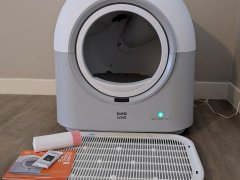
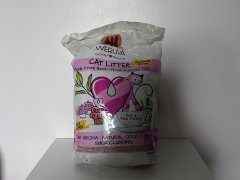






If you how where you can buy a LitterMaid. Please send a email. The mfg has quit making them. I had one almost 3 years it finally quit working. This was the best purchase I had ever made.
All is true in this review, but there’s an important distinction left out – and it almost never gets mentioned about Litter Robot’s design.
We’ve owned two Litter Robots over the last decade or so. Both had the same issue that ultimately led us to going back to, as tedious as it is to maintain, a Littermaid. The Litter Robots consistently drop litter dust / residue on the backs of our cats. It’s an unavoidable consequence of the LR’s horizontal-turning globe design. The litter – and the waste – slides along the sides and into the sifting grate. The grate holds on to residue even after it’s completed a cycle. The cats enter to do their business and residue ends up falling on top of them, exactly where – on their heads, back, tails – depends on what positions they take in the globe.
I’ve seen a few people say “well I never see any on my cat.” To me, that’s a sign their cats have already licked it off. Our cats tend to come straight back to us after doing their business (not sure why, but thanks?). Every time they did with the LR, they always had residue somewhere on them. That can mean cat litter itself, dried urine, and/or fecal residue… not just on their feet, but anywhere from nose to tail on their coats.
So no. I’d rather have the tedious, under-designed LM since it doesn’t rain pee / poop / cat litter residue down from above on the cats. I do wish they’d create a better designed rake system – even Littermaid itself could vastly improve upon their own product (better motor, more stable & effectively positioned rake… offering an optional cabinet with plastic kitchen-bag chute for increased capacity. We own one made from a now-defunct 3rd-party called LitterWorks, which improves things dramatically for a multi-cat household.
But innovation doesn’t seem to be of interest to LitterMaid just making as much money they can on their existing “average” product. One small improvement they could easily do, that would make ALL the difference, is allow the rake to go TWO times in a cycle… cleaning up the initially stuck-to-rake clumps that fall off during the first swipe’s return. Just a suggestion to the universe!
There have been a couple of new products that avoid the LR’s residue-from-above issue: The PetSnowy has a vertical-turn globe with an open-ceiling over the portion where the cat sits. But it also encases all of it inside its own claustrophobic box, and has a very complicated entry point… And last but not least, a rather small waste drawer that cannot easily be modified for something like a waste chute. For the life of me, I don’t understand why these inventors over-design so much. And there’s the Popur, which really seems to redefine the rake / globe concepts into one great idea. But then they ruin it by refusing to have optical safety sensors AND providing a substandard litter floor liner (they think “water-resistant nylon” is acceptable… I guess they don’t realize that water isn’t acidic, and also not the same as URINE or feces?)
For us, the LM is just an “assist” to keep the litter mostly clear for the cats during the day. And every night, as this review references, one of us uses the scooper to clean up the litter stragglers. Still, I’d rather than do that than have any litter residue rain down on top of our cats.
Great observation. I also wish we had more open-roof options that worked well.